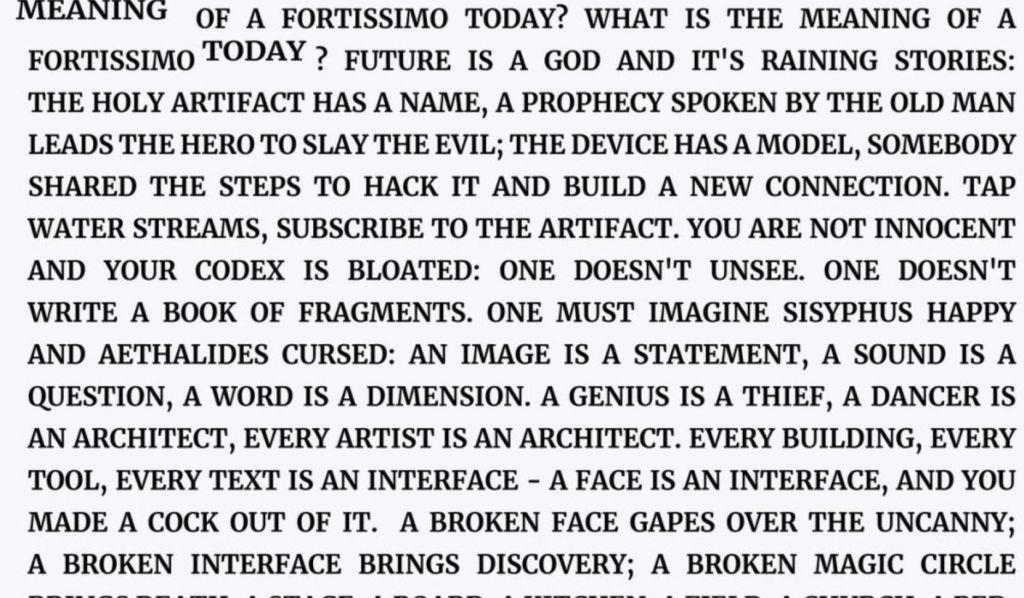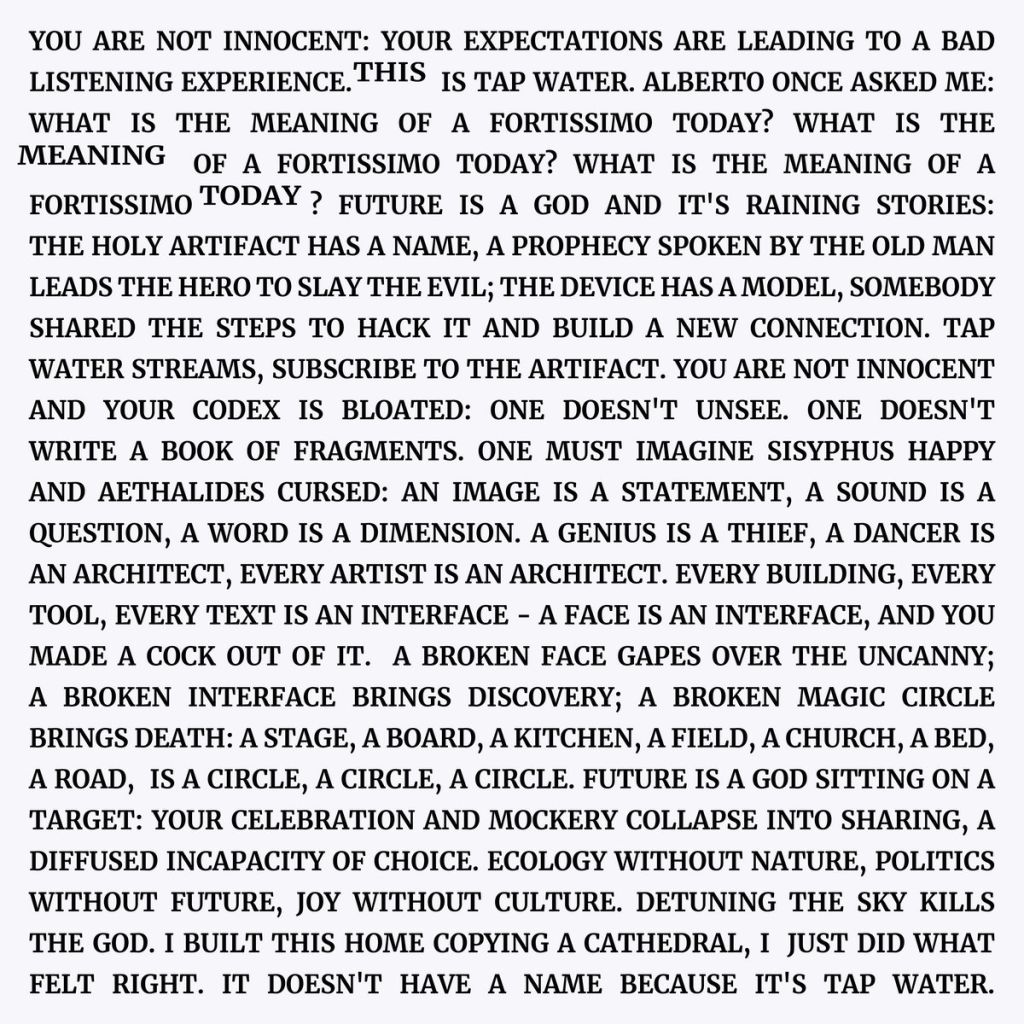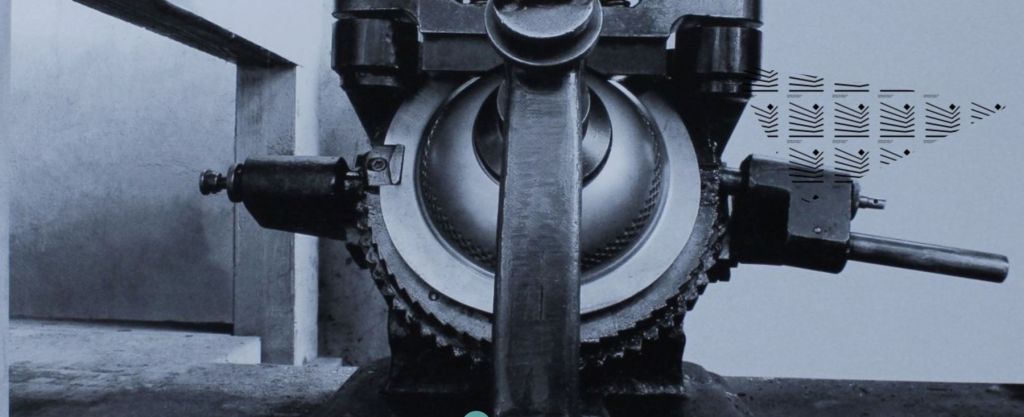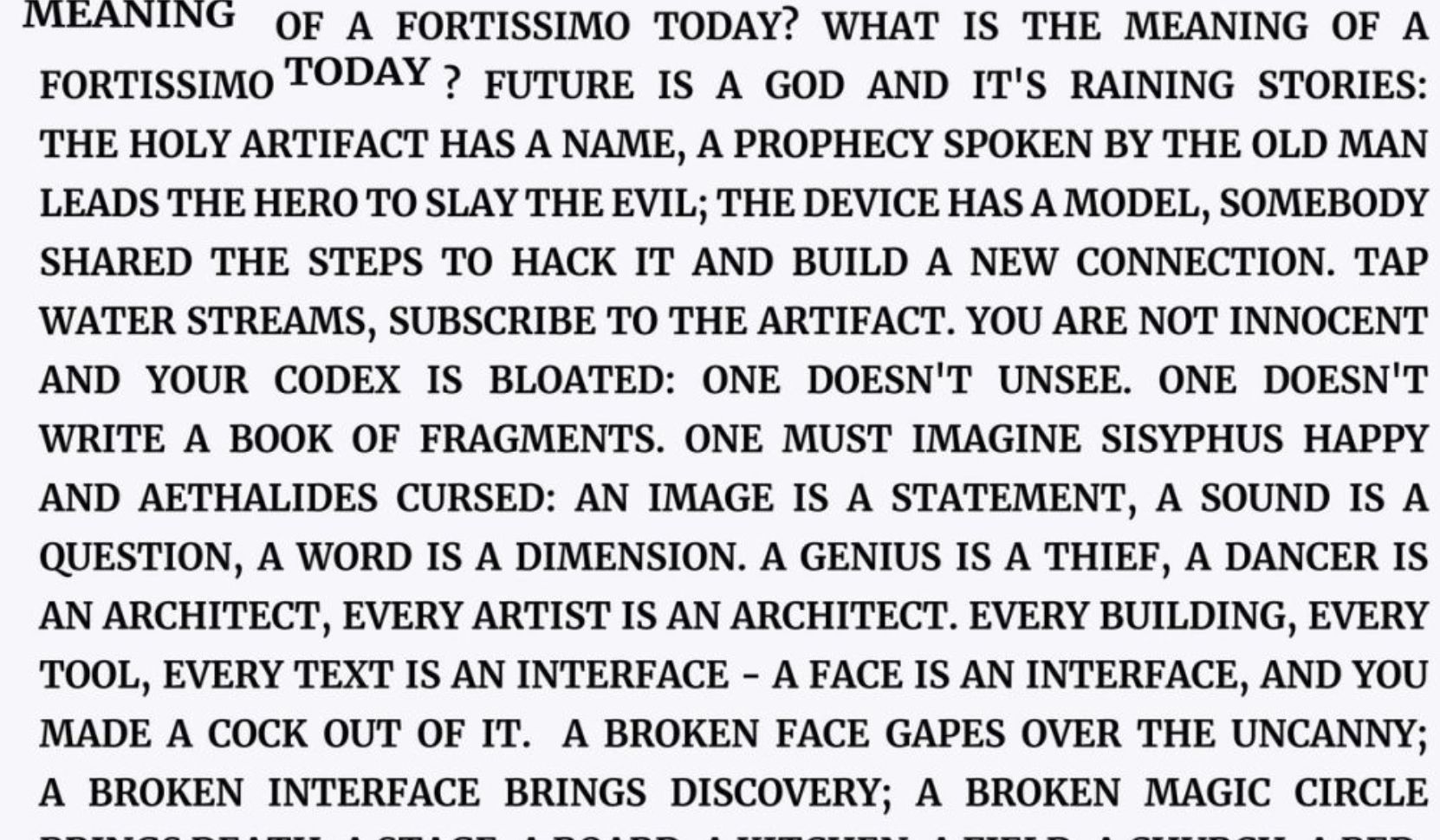Interview by Miguel Isaza

It’s common to think of music in terms of genres, currents or trends as if sonority was always predisposed to compartments implanted by categorical thought, where not only certain strict identities tend to be generated for rhythmic and melodic models, but also the sounds themselves fall into classifications often vain to represent them.
Although there are various types of works that can be pigeonholed into specific styles, many others escape classification, often falling into more general ones such as “experimental”, “alternative”, or “other”. But there are also adventurous proposals that transcend not only genres but also open cracks in, subvert, and question them, wandering in their potholes and in-betweens.
Such is the music of Bienoise, aka Alberto Ricca, a prolific artist, composer, educator and thinker of sound, eager to find creative states that do not depend on focusing on any genre, instead jumping from one to another without sacrificing his own style, and instead defining a unique way of composing by merging all kinds of elements that could suggest styles as diverse as breakcore, ambient, jungle, folk or techno, but ends up blurring them in favour of a richer experience.
That process comes with a series of sonic figures resulting from the cross-pollination of methods and the adoption of a wide plethora of concepts and techniques, allowing samples of recorded music to coexist with glitch, prepared CDs, field recording, beats programmed in the grid or totally alienated from it through exquisite forms of time-stretching, shadows of dub or the presence of complexity in structures, cuts, breaks, tones and concrete forms, all of them permeated by a pure sonic heterogeneity and attentive dynamism that many of his works condense.
In Bienoise’s compositions, deep aesthetic reflection and instrumental knowledge converge, which is also present in his activity as a performer, programmer and teacher, as reflected in projects such as the Frames 2.0 spectral synthesiser, explorations in VR such as the Hic Sunt Dracones project or the procedural archive for industrial archaeology’ Industrial Soundscape’.
Although leaving Ricca’s approach in mere virtuosity would be a fallacy: he is, above all, a listener, a true alchemist of sound who is not only concerned with the sonic composition but also with its criticism, its thought, and contemplation. In his case wide, detained and diverse, as also shown in the curation of his own label Floating Forest Rec and in the vast medley that runs through his discography.
In works such as Meanwhile Tomorrow (White Forest Records, 2015), he gets oriented towards his authentic view of the dance floor, while in other experiments such as Sono una Teiera Tonda Tonda Il Mio Beccuccio È A Forma D’Onda (Bitcrusher Records, 2010/2020) he flaunts his versatility and the capacity to intertwin styles and transgress them until reaching diverse forms such as his works published in the legendary Mille Plateaux: Most Beautiful Design (2018) and This Meaning Today (2022), the latter being the reason for our conversation today with such a seasoned master of contemporary electronics.



So you were born in the VCO, a quiet town in the north of Italy. How has the place you grew up influenced your music, and how do you get inspiration for your art?
Growing older, I started wondering the same question: of course, the ominous melancholic contemplation of Boards of Canada perfectly describes any “beautiful place out in the country”, but there’s much more. As I like to repeat, culture for me has always been (in the words of Romeo Castellucci) a matter of choosing, of taking the effort to reach for what I was interested in. In the 90s, I had access to few things, so my interests were mainly in bricks (Lego, sandbox videogames, recorders, musical instruments, hacking, anything that I could use to make something else); once I was reached by the Internet, it quickly became a virtual hometown, an endless source of answers and new questions, a map to the new geography of ideas we are living in that I celebrated in the dance piece ‘To Be Banned From Rome’.
You have a Bachelor’s in Electronic Music and Sound Technologies, and you have also been a teacher. Are you still working on that academic side of music? I wonder how it affects or relates to your artistic practice.
I am still teaching in an academy, and I love it: I feel I am a teacher by nature because I love sharing enthusiastically what I feel is interesting and positive to push curiosity and dialogue. It’s the most political thing I can conceive.
You describe yourself as a fetishist around boundaries of genres, styles, instruments and aesthetics. What triggered this middle ground for your musical perspective? What keeps pushing you to place yourself in between and not in a specific style? Any influences that showed you such path?
A friend of mine says that I’m more interested in concepts than in music. That’s probably true: I cannot see myself as just a musician; I’m a tridimensional human being, a son, a cinephile, a mammal, a dungeon master who found joy in manipulating abstract ideas through music. That’s why my music can sound awkward sometimes: I enjoy the feeling of something that’s barely working, that moment in which some sine waves and blobs of silence become an Onkyokei track when a sparse and complex beat clicks and grooves in a Dubstep or Glitch track. Anything works in the right context; recognising it is the real struggle.
How does this aesthetic pluralism also affect your methodology and technique? I see you develop Max/MSP patches and use a combination of techniques, from sampling to field recording and beat programming. How has this technical perspective changed over the years?
I got better! After some time, you start seeing similar patterns in very distant materials and find more and more ways to get the results that you enjoy: for example, recently, I worked a lot with machine learning (starting with the amazing breaks that Dadabots kindly generated for me, then working with the algorithms by myself), because of course I love the drowning, choking, an undecided prismatic sound that you can get in this golden age of neural networks. It’s just a new tool, like probability, mp3 compression, and repetition, that gets me a result I recognise as “home”, even if it’s different from anything else.
Along with this mashup of things, there seems to be an interest in several of your releases around sound destruction, time-stretching, diversity of synthesis methods, digital artefacts, quality degradation, and diverse glitch/processing aesthetics contrast with more calculated/structured rhythms and melodic content. How do you find the balance between all those elements? Is there a kind of formula or strategy you like to follow when approaching sonic matter?
For this album, I had to answer this precise question. The answer was: accept your Cathedrals, all those elements that you seem to always return to gravitationally. Then you can build your city around them: at some point, your whole life becomes training for making the right choice when creating art: again, a matter of constant choice and effort in eating the right (or very wrong!) things to build your taste. My main rule is: don’t fall in love with solutions; you can always use that patch or that sequence somewhere else, but try to spot strong ideas and allow them to shine. Learn to listen, in short.
In your release Most Beautiful Design, there’s a very interesting perspective that, despite lacking certain dance/beat-making approaches of other releases of yours, makes place for a more granular, glitch aesthetic which doesn’t seem approached merely as a texture but also as melody, with resonant patterns and attention towards tonality. Is that something you were seeking in that release? What were you searching for on that particular album?
Most Beautiful Design had a very clear goal and required a lot of experiments to get there: I painstakingly wrote and rendered many tracks before I understood what result I could get with a variation in the spectrum or in the dynamics when the track was later rendered as a 16 kbps mp3. So yes, while at the beginning it was just a long experiment in using a technology never used before for composing, once I selected what was good, any result was expected and wanted: I greatly enjoy how mp3 compression results in a kind of low-fi that doesn’t just mask information but adds them, and it’s the first time that I recognized myself in a sound. Often, for me, the beat is an instrument and not an end in itself: MBD lacks them because any percussion I tried just didn’t work.
In your new album This Meaning Today, there’s a solid statement around music conceptualisation and the emphasis on listening without meanings. It kind of reminds me of the reduced listening approach in the early days of concrete music. However, you don’t seem to be very interested in establishing theory but in subverting and opening the listener’s mind, plus suggesting some ideas in the listener’s mind, plus suggesting some ideas in the visual/textual aspect of the track ‘OOO’ video. How do you approach this ‘meaningless’ perspective and develop and avoid expectations in terms of your choices while creating and in the things you want to ask, open or offer to the listener’s position/invitation? Do you think there is an irrational process, or is it more about a strategy of abstraction and a kind of conceptual game?
The emphasis in most of what I do today is on listening as an invitation to openness. Listening constantly to fish for unexpected ideas; listening when creating, to give those ideas the best frame to shine; listening when experiencing someone else’s work, not necessarily to understand it but at least to understand our reaction to it – how some elements, even if unintended, generate a sensation.
For this album, and for the recent period of my creative work, I tried to be open and identify all the elements that I enjoy, and I often avoided in the years because they were strange or awkward: scrolling texts (movie credits, but also late night Reddit diving), repetitive or peculiar structures in songs, using maximalism to create themes without a clear melody and so on. I don’t care about subverting expectations or being original for the sake of being original: that’s not listening; that’s peer\self pressure. Gadamer says: “from the surplus of meaning, a work of art is made inexhaustible and bigger than any translation in concepts”, and that’s a call for the listener\spectator to stop being passive and participate in the ritual.
In that track OOO, you refer to Object-Oriented Ontology, a theory that similarly speaks about the complexity of things you reflect on the project. As Graham Harman says, objects create caricatures of themselves while they interact. Do you think that also applies to musical decisions and/or sound objects? Also, besides the track name, has object-oriented philosophy influenced this work in any way? And what would be your idea of a ‘sound object’ nowadays?
In the texts I wrote for the album, I often repeat, “You never write a book of fragments \ the truth of a text is never really written anywhere”, quoting Eugene Thacker and Rosi Braidotti. Those are two very important concepts for me, as I feel that, put simply, having a polyphonic relationship of meaning between elements gives the listener a much more fulfilling experience than just explaining everything – a huge problem today, in an era of clubs filled with conceptual music (I see the irony in saying so in this interview) and cinemas filled with expanded universes. Remember that a sound is a question, and not even Tolkien explained everything.
So yes, the dark core of any object is an exciting thing, and so is the web of relationships it has with any object (including the listener). Pretty much anything you can give a name to is an object, and objects often get culturally relevant: the Amen Break, Supersaw waves, grim and frostbitten Blast Beats…they become signatures, memes, and very powerful tools, but we’re still making art for other humans and to try to elicit the same response in everyone we should level our expression to the most common tropes – and that’s not art, that’s advertising.
There’s also a critique on the current state of music making/publishing/listening and what it means to release music ‘today’, a political statement around time, productivity and the music industry. Where does this come from, and why do you think it should be the way to deal with it? Is it more about simply leaving meaning behind or rather about wanting to reconsider the idea of meaning as such and find new ways of interpreting what we create and listen to?
Meaning is a tool, so I’m not suggesting leaving it behind: if you feel it’s important for your creations to have a concept or a metaphor, go for it. For me, music, as dance, is an art of the sensation, not of the meaning. The “meaning” I talk about is mainly the lost aura of the work of art Walter Benjamin talks about: but as sharing becomes content, or an excuse to avoid choosing between celebrating something or making fun of it, it loses even any political strength Benjamin saw in it. In an age where commercials are prettier and deeper than any work of art, we should probably follow Žižek’s advice and display shit.
You talk about the idea of music as a device for ‘suggesting silence’, which makes me wonder what silence means for you? How do you conceive and apply it in your work, and how is it related to your idea of listening?
I fear there’s not much actual silence in my music, except for the silence of the voice of the author, as John Cage would say: I often try to sublimate ideas from materials or processes (field recordings, glitching gear, algorithms…) and start building a stage to display those ideas that I recognize as strong. But there’s a lot of silence in my life.
What is your chief enemy of creativity?
The obvious. We made a cock out of it.
You couldn’t live without…
Discovery and wonder.






